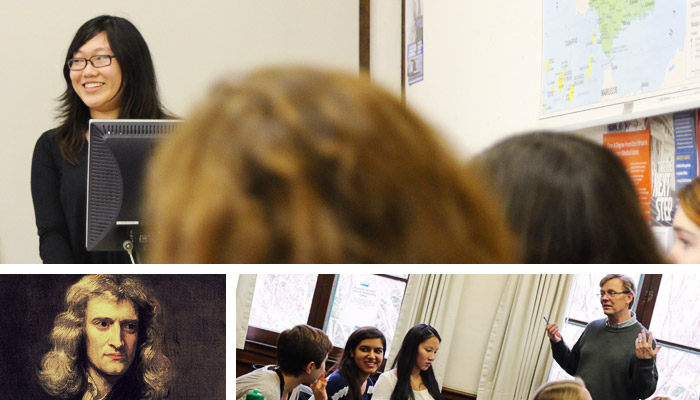
A centuries-old controversy has made its way to Claremont: who first invented calculus? Was it English physicist and mathematician Sir Isaac Newton – widely regarded as one of the most influential scientists of all time – or Gottfried Leibniz, a brilliant polymath with similar achievements in law, economics, and politics? The debate – and the enmity spawned in its wake – is just part of the fascinating history of this branch of mathematics, one Christine Chao ’17 is happy to sprinkle with salacious details and political machinations.
“England became disconnected from Europe as a result of this controversy,” she says. “And since history isn’t taught in most calculus classes, this project helped me view it in a different light. It was really a unique experience.”
Chao is one of a dozen students in Professor Chris Towse’s Mathematics in Our Culture, a Core III class that asks its students to question and rethink what they think they know about math, education, and who they are. Towse has taught a version of this course four times since 2004.
“I try to make my Core III a culminating experience,” he says. “The students are often surprised at what part of their investigations inspire them the most. It’s fascinating to watch and encourage them through the process.”
Final projects have included documentary films and novellas over the years. Cosette Dwyer, a sophomore from Cypress, California, incorporated math and general Core concepts into a tale about a high school student whose confidence in her math skills was diminished by peer expectations. The story drew on her personal experiences.
“I hope to promote STEM courses with minorities and girls,” she says. “Studying how our culture perceives math and math education is a big first step, and Professor Towse’s course helped me realize why I had little confidence in my math abilities while in high school. For those with similar issues, this class could help.”
Towse agrees: “I hope I give a sense that my students are able to control their own education, that they have a creativity within them to lead and guide them through new, uncomfortable ideas.”
While Towse has taught at several institutions of higher learning, his experience as an instructor is unique when it comes to Core. “Very few treat the subject matter this way, as a humanistic endeavor and part of our culture.”
Dwyer’s key takeaway from the course? “There’s no such thing as ‘math people,'” she says. “Everyone has the ability to learn, even if they have unfortunate experiences that make them believe they can’t.”
As with most Core classes, the teacher often learns as much as their pupils. During one discussion, Towse made an off-hand comment about one of his calculus classes. “My class spends a lot of time thinking about the way math is taught,” he says. “My class rightly called me out for what I said, and I rethought my attitude and approach to the material.
“Just as I had asked them to rethink their assumptions, I had to do the same.”

